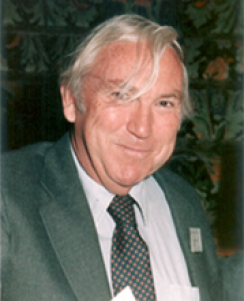Hall Of Fame Inductees
The individuals nominated should have made a significant impact or positive influence that assures the future of our industry in the lives of generations to come.
Once nominated, an individual’s biography and photo are updated on the site, and he or she is placed in the polls for voting. At the end of the year the committee takes into consideration the votes and decides which candidates are inducted.
Those with a star (*) next to their name below were either inducted posthumously or have passed away since being inducted.
Nomination Qualifications
- Person with integrity and passion
- Minimum 20 years in industry
- Someone who has developed or invented new technology
- Has made contributions that resulted in change
- Contributed to mankind’s needs in his field
- Provided education and encouragement with self-sacrifice
- Changed the industry
Donald M. Roberts *
Landscape Architect UCLA
Donald M. Roberts, FASLA, led Southern California and the world of Landscape Architecture into a new age. The story of his life reads like that of a movie character whose energetic, selfless efforts to improve his profession, both in practice and on the educational front, was part of a visionary adventure.
The only child of a California architect, Don was a Registered Landscape Architect whose career spanned public, private, and academic borders and has crossed oceans. He was also a conscientious objector, photographer, crop-duster, forest fire fighter, zoo animal transporter, plant hunter, supplier, and landscape contractor, environmental preservationist, gardener and newspaper columnist, author, editor, and historian, teacher, academic, promoter, politician, diplomat, husband, and father.
The industrial landscape maintenance firm he ran in the 1950's garnered such clients as Katherine Hepburn and David Niven and attracted landscape design projects. Plant hunting for Walt Disney with Bill Evans for the grand opening of Disneyland was this firm's last project. Don concentrated on design and briefly joined Courtland Paul's celebrated landscape architectural firm.
Piloting developers to sites statewide led Don to establish a new practice in the 1950's and 60's. Located for a time in "Jungleland," his new company prepared 15 park studies and master plans for 12 cities, including Simi Valley, Thousand Oaks, and parts of Westwood (he even flew the aerials for Westwood). As Resident Landscape Architect of the new city of Thousand Oaks, he worked to restrict development from obstructing views on ridgelines, graduate lot sizes to reduce lot slippage on slopes, preserve stands of oaks and native trees, limit removal of natural ground cover, and require greenbelts between developments, writing the state's first such environmental ordinances for public lands.
Now widely known as an educator, Don joined the faculty at UCLA as a lecturer in the Department of Art, Design and Art History in 1967; his progressive career in community master planning and design were sufficient qualifications. In l974, at nearly 50, he got his Bachelor’s Degree in anthropology at the University of Redlands and was then appointed head of landscape architectural studies until his retirement with emeritus status in 1981.
The UCLA sculpture garden designed by Cornell, Bridgers, & Troller was a dramatic departure from "beaux arts" designs of the Mission Revival period and became a dynamic teaching arena for him. "Don used that garden to usher in a new breed of landscape architects," said Howard Troller, who designed the garden. Chairman of the Department of Landscape Architecture at Cal Poly Pomona, Ken Nakaba, taught with Roberts at UCLA in the 1960's and called him "an engaging teacher who worked well with students. I met Don at mid-career, but his inquisitive nature rubbed off on me and gave me new directions."
As head of landscape architectural studies at UCLA, Roberts gave new direction to professionals worldwide. He founded the University Extension Program in Landscape Architecture that became the model program in the U.S. and abroad. Roberts promoted education to the profession and professionalism to academia. He co-authored a l983 study that paved the way for the Uniform National Exam.
Perhaps his understanding of cultural change made him such a tireless advocate for the landscape architectural community as an evolving profession. He was a founding member of the American Institute of Landscape Architects in 1957 along with Warren Lawson, Dick Gawne, Arnold Dutton, Lee Scharfman, Joe Lenisch, W. Bennett Covert, and Courtland Paul. "AILA was an outgrowth of the industry's need to recognize registered licensed professionals on the same level as academically trained landscape architects," recalls Courtland Paul of Peridian. "As with most of us, Don resented the fact that we were 'perceived' as second class citizens and he worked tirelessly toward unification of AILA with ASLA."
Another AILA leader, Bob Cardoza, principal with NWIS (formerly Cardoza, DiLallo & Harrington) was impressed by his thoroughness of effort and dedication to detail 'for the good of the profession.' "As President of AILA at the time, I have a deep appreciation of his ability to orchestrate the timing of the unification to preserve the voting rights of AILA members," said Cardoza about Roberts' aptitude for politics and diplomacy. In 1988, in another effort for the good of the profession, he personally contacted many of the 23,000 professionals in over 90 countries to self-publish the World Directory of Landscape Architects, the first directory to facilitate worldwide business and social interaction between all segments of the landscape industry.
Stemming from complications due to a heart operation in late 1991, Don died in his Tustin apartment, April 11,1994 surrounded by a collection of the subtropical plants he loved.


